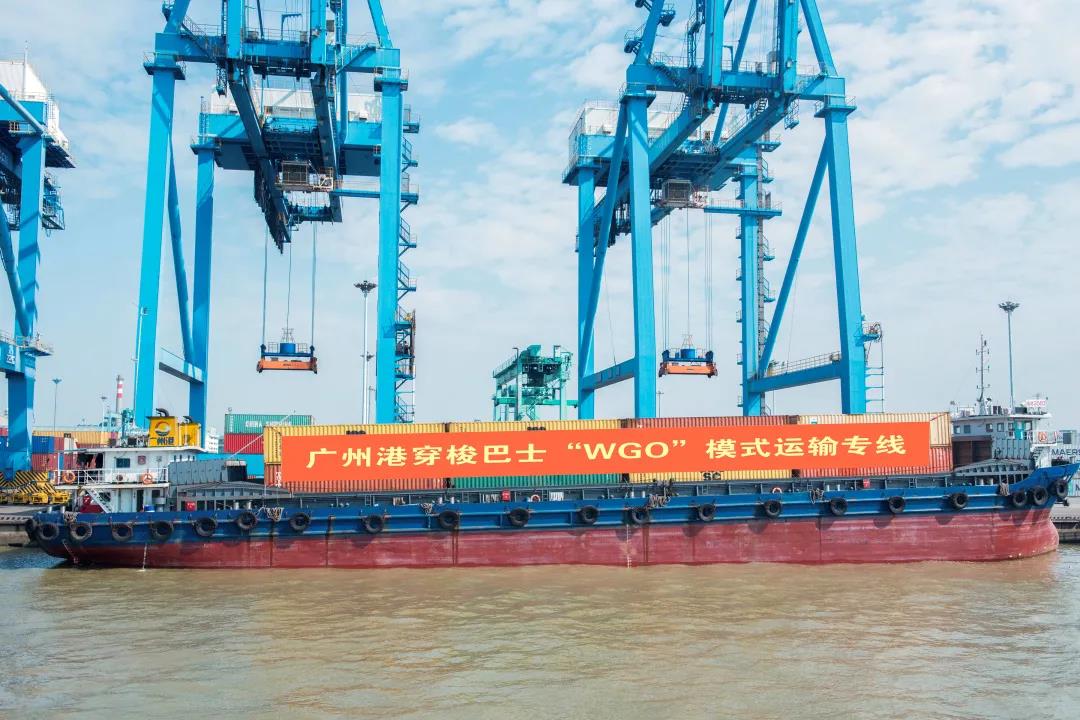Multiple Measures Are Taken to Smooth the Water Logistics Chain in the Greater Bay Area by Guangzhou Port Shuttle Bus (Picture)

Recently, after being informed that a famous refrigerator enterprise in Zhongshan is eager to export its refrigerators, the person in charge of Zhongshan Office of Guangzhou Port Shuttle Bus actively contacted the customer, guided the customer to choose WGO mode for export, and won the support of many shipping liner companies. After the concerted efforts of various parties, a Guangzhou Port shuttle bus that carried 78 empty 40-foot containers arrived at Zhongshan Port from Nansha Port Area on the night of June 12, and then transported them to the factory with trailer barge in collaboration with Zhongshan Port & Shipping Group; the Guangzhou Port shuttle bus that carried containers loaded with goods successfully arrived at Nansha Port on the evening of June 13, and the goods were directly shipped for export.
Since May, affected by the COVID-19 pandemic, the port of call of a number of international liner routes have been adjusted, the Nansha Port Area of Guangzhou Port has featured more intensive routes and busier terminals, and container pick-up trailers have arrived at the port intensively. Guangzhou Port Shuttle Bus has spared no efforts in epidemic prevention and control and production organization and coordination, and has taken the initiative to plan and optimize logistics service schemes for customers to ensure the smooth flow of cargoes imported and exported in the Greater Bay Area ports.
Scientifically organize production and implement closed-loop management According to the market dynamics, Guangzhou Port Shipping Company timely improves the transport capacity of Guangzhou Port shuttle buses, and increases the transport capacity to 146,700 tons by integrating all resources, a year-on-year increase of 15%; meanwhile, the company increases number of runs to meet customers’ different booking requirements; during the special period, the crew are subject to closed-loop management and don’t change shifts in principle, so as to ensure the uninterrupted service around the clock. From the end of May to the mid-June, the shuttle bus transported nearly 100,000 TEU in a safe and orderly manner.
Innovate service mode and solve customers’ practical difficulties In the face of the current strain of shortage of international container transportation market capacity and containers, the communication with shipping company have been strengthened, and customers’ difficulties in container pick-up are overcome through urging the shipping company to release shipping space and extending container use period, which have effectively mitigated the pressure on cargo overstocking, warehousing & storage and cost increase facing a batch of small and medium-sized enterprises in Zhongshan, Foshan, Dongguan and other cities in the Pearl River Delta. Meanwhile, the customers’ valuable time and cost have been saved through diversified WGO pattern such as pick-up of empty containers, loading and return of the loaded containers, pick-up of empty containers with trailer, loading and return of the loaded containers by ship and pick-up of loaded containers and return of empty containers in a different place. Recently, the traditional WGO transportation time has been reduced by 2 days through launch of the port pick-up mode of empty containers through coordination with all parties.
Currently, shutter bus WGO pattern has been promoted in many ports in the Pearl River Delta. There are 10 sites at present. Many customers have signed the contracts to adopt WGO pattern for export amid the epidemic. Guangzhou Port has opened 71 “Shutter Bus” barge branch lines, basically covering the major regions of the Pearl River Delta. During the “13th Five-Year Plan” period, the transport capacity of shuttle buses had increased by 58.4%. Innovations have been made in business and regulatory models such as WGO, combined ports, One Port for connected Bay Area & Nansha and same ship transportation for domestic and foreign trade, and the policies for departure ports have been further implemented. (Liang Yali and Chen Jing)
News
- Xinsha Company Saw A Year-on-year Increase of 10.55% in Cargo Throughput in the First Quarter (Picture)
- 24,188 TEUs! The world's largest container ship calls at Nansha Port Area of Guangzhou Port (Picture)
- “Nansha-Hengyang” Pulp Special Line Launched (Picture)
- Good Start and Good Progress! Nansha Phase III Production Hit a Good Result (Photo)
- The National Consumption Promotion Month & Guangdong Automobile Consumption Festival Kicks Off in Guangzhou Port (Picture)